Identification and Validation of Potential Ferroptosis-Related Genes in Glucocorticoid-Induced Osteonecrosis of the Femoral Head
Abstract
1. Introduction
2. Materials and Methods
2.1. Data Information
2.2. Ferroptosis-Related Genes Detection
2.3. Ferroptosis-Related DEGs Analysis
2.4. GO and KEGG Enrichment Analyses of Ferroptosis-Related DEGs
2.5. PPI Network Analysis
2.6. Validation of the Hub Genes
3. Results
3.1. Identification of Ferroptosis-Related DEGs
3.2. GO and KEGG Enrichment Analyses of Ferroptosis-Related DEGs
3.3. PPI Network Analysis
3.4. Validation of the Hub Genes
4. Discussion
5. Conclusions
Author Contributions
Funding
Institutional Review Board Statement
Informed Consent Statement
Data Availability Statement
Conflicts of Interest
References
- Moya-Angeler, J.; Gianakos, A.L.; Villa, J.C.; Ni, A.; Lane, J.M. Current concepts on osteonecrosis of the femoral head. World J. Orthop. 2015, 6, 590–601. [Google Scholar] [CrossRef]
- Guerado, E.; Caso, E. The physiopathology of avascular necrosis of the femoral head: An update. Injury 2016, 47 (Suppl. S6), S16–S26. [Google Scholar] [CrossRef]
- Erken, H.Y.; Ofluoglu, O.; Aktas, M.; Topal, C.; Yildiz, M. Effect of pentoxifylline on histopathological changes in steroid-induced osteonecrosis of femoral head: Experimental study in chicken. Int. Orthop. 2012, 36, 1523–1528. [Google Scholar] [CrossRef]
- Cai, J.; Li, H.; Zhang, C.; Chen, Z.; Liu, H.; Lei, F.; Qin, J.J.; Liu, Y.M.; Zhou, F.; Song, X.; et al. The Neutrophil-to-Lymphocyte Ratio Determines Clinical Efficacy of Corticosteroid Therapy in Patients with COVID-19. Cell Metab. 2021, 33, 258–269.e253. [Google Scholar] [CrossRef] [PubMed]
- Seguro, L.P.; Rosario, C.; Shoenfeld, Y. Long-term complications of past glucocorticoid use. Autoimmun. Rev. 2013, 12, 629–632. [Google Scholar] [CrossRef] [PubMed]
- Wang, C.; Wang, X.; Xu, X.L.; Yuan, X.L.; Gou, W.L.; Wang, A.Y.; Guo, Q.Y.; Peng, J.; Lu, S.B. Bone microstructure and regional distribution of osteoblast and osteoclast activity in the osteonecrotic femoral head. PLoS ONE 2014, 9, e96361. [Google Scholar] [CrossRef] [PubMed]
- Dixon, S.J.; Lemberg, K.M.; Lamprecht, M.R.; Skouta, R.; Zaitsev, E.M.; Gleason, C.E.; Patel, D.N.; Bauer, A.J.; Cantley, A.M.; Yang, W.S.; et al. Ferroptosis: An iron-dependent form of nonapoptotic cell death. Cell 2012, 149, 1060–1072. [Google Scholar] [CrossRef]
- Hadian, K.; Stockwell, B.R. SnapShot: Ferroptosis. Cell 2020, 181, 1188–1188.e1181. [Google Scholar] [CrossRef]
- Jeney, V. Clinical Impact and Cellular Mechanisms of Iron Overload-Associated Bone Loss. Front. Pharmacol. 2017, 8, 77. [Google Scholar] [CrossRef]
- Latunde-Dada, G.O. Ferroptosis: Role of lipid peroxidation, iron and ferritinophagy. Biochim. Et Biophys. Acta Gen. Subj. 2017, 1861, 1893–1900. [Google Scholar] [CrossRef]
- DeHart, D.N.; Fang, D.; Heslop, K.; Li, L.; Lemasters, J.J.; Maldonado, E.N. Opening of voltage dependent anion channels promotes reactive oxygen species generation, mitochondrial dysfunction and cell death in cancer cells. Biochem. Pharmacol. 2018, 148, 155–162. [Google Scholar] [CrossRef] [PubMed]
- Jia, P.; Xu, Y.J.; Zhang, Z.L.; Li, K.; Li, B.; Zhang, W.; Yang, H. Ferric ion could facilitate osteoclast differentiation and bone resorption through the production of reactive oxygen species. J. Orthop. Res. Off. Publ. Orthop. Res. Soc. 2012, 30, 1843–1852. [Google Scholar] [CrossRef] [PubMed]
- Balogh, E.; Tolnai, E.; Nagy, B., Jr.; Nagy, B.; Balla, G.; Balla, J.; Jeney, V. Iron overload inhibits osteogenic commitment and differentiation of mesenchymal stem cells via the induction of ferritin. Biochim. Et Biophys. Acta 2016, 1862, 1640–1649. [Google Scholar] [CrossRef]
- Sun, F.; Zhou, J.L.; Liu, Z.L.; Jiang, Z.W.; Peng, H. Dexamethasone induces ferroptosis via P53/SLC7A11/GPX4 pathway in glucocorticoid-induced osteonecrosis of the femoral head. Biochem. Biophys. Res. Commun. 2022, 602, 149–155. [Google Scholar] [CrossRef]
- Petrigliano, F.A.; Lieberman, J.R. Osteonecrosis of the hip: Novel approaches to evaluation and treatment. Clin. Orthop. Relat. Res. 2007, 465, 53–62. [Google Scholar] [CrossRef]
- Kang, J.S.; Park, S.; Song, J.H.; Jung, Y.Y.; Cho, M.R.; Rhyu, K.H. Prevalence of osteonecrosis of the femoral head: A nationwide epidemiologic analysis in Korea. J.Arthroplast. 2009, 24, 1178–1183. [Google Scholar] [CrossRef]
- Mont, M.A.; Cherian, J.J.; Sierra, R.J.; Jones, L.C.; Lieberman, J.R. Nontraumatic Osteonecrosis of the Femoral Head: Where Do We Stand Today? A Ten-Year Update. J. Bone Jt. Surgery. Am. Vol. 2015, 97, 1604–1627. [Google Scholar] [CrossRef]
- Tsukanaka, M.; Halvorsen, V.; Nordsletten, L.; EngesæTer, I.Ø.; EngesæTer, L.B.; Marie Fenstad, A.; Röhrl, S.M. Implant survival and radiographic outcome of total hip replacement in patients less than 20 years old. Acta Orthop. 2016, 87, 479–484. [Google Scholar] [CrossRef]
- Jing, X.; Du, T.; Yang, X.; Zhang, W.; Wang, G.; Liu, X.; Li, T.; Jiang, Z. Desferoxamine protects against glucocorticoid-induced osteonecrosis of the femoral head via activating HIF-1α expression. J. Cell. Physiol. 2020, 235, 9864–9875. [Google Scholar] [CrossRef] [PubMed]
- Lin, T.; Chen, W.; Yang, P.; Li, Z.; Wei, Q.; Liang, D.; Wang, H.; He, W.; Zhang, Q. Bioinformatics analysis and identification of genes and molecular pathways in steroid-induced osteonecrosis of the femoral head. J. Orthop. Surg. Res. 2021, 16, 327. [Google Scholar] [CrossRef] [PubMed]
- Li, T.; Zhang, Y.; Wang, R.; Xue, Z.; Li, S.; Cao, Y.; Liu, D.; Niu, Y.; Mao, X.; Wang, X.; et al. Discovery and validation an eight-biomarker serum gene signature for the diagnosis of steroid-induced osteonecrosis of the femoral head. Bone 2019, 122, 199–208. [Google Scholar] [CrossRef]
- Chen, G.; Zhong, L.; Wang, Q.; Li, Z.; Shang, J.; Yang, Q.; Du, Z.; Wang, J.; Song, Y.; Zhang, G. The expression of chondrogenesis-related and arthritis-related genes in human ONFH cartilage with different Ficat stages. PeerJ 2019, 7, e6306. [Google Scholar] [CrossRef] [PubMed]
- Chen, L.; Xiong, Y.; Yan, C.; Zhou, W.; Endo, Y.; Xue, H.; Hu, Y.; Hu, L.; Leng, X.; Liu, J.; et al. LncRNA KCNQ1OT1 accelerates fracture healing via modulating miR-701-3p/FGFR3 axis. FASEB J. Off. Publ. Fed. Am. Soc. Exp. Biol. 2020, 34, 5208–5222. [Google Scholar] [CrossRef]
- Yang, N.; Liu, Y. The Role of the Immune Microenvironment in Bone Regeneration. Int. J. Med. Sci. 2021, 18, 3697–3707. [Google Scholar] [CrossRef] [PubMed]
- Anesi, A.; Generali, L.; Sandoni, L.; Pozzi, S.; Grande, A. From Osteoclast Differentiation to Osteonecrosis of the Jaw: Molecular and Clinical Insights. Int. J. Mol. Sci. 2019, 20, 4925. [Google Scholar] [CrossRef]
- Gangji, V.; Hauzeur, J.P.; Schoutens, A.; Hinsenkamp, M.; Appelboom, T.; Egrise, D. Abnormalities in the replicative capacity of osteoblastic cells in the proximal femur of patients with osteonecrosis of the femoral head. J. Rheumatol. 2003, 30, 348–351. [Google Scholar]
- Elmore, S. Apoptosis: A review of programmed cell death. Toxicol. Pathol. 2007, 35, 495–516. [Google Scholar] [CrossRef]
- Moutsatsou, P.; Kassi, E.; Papavassiliou, A.G. Glucocorticoid receptor signaling in bone cells. Trends Mol. Med. 2012, 18, 348–359. [Google Scholar] [CrossRef]
- Zhu, C.Y.; Yao, C.; Zhu, L.Q.; She, C.; Zhou, X.Z. Dexamethasone-induced cytotoxicity in human osteoblasts is associated with circular RNA HIPK3 downregulation. Biochem. Biophys. Res. Commun. 2019, 516, 645–652. [Google Scholar] [CrossRef]
- Bai, R.; Liu, W.; Zhao, A.; Zhao, Z.; Jiang, D. Nitric oxide content and apoptosis rate in steroid-induced avascular necrosis of the femoral head. Exp. Ther. Med. 2015, 10, 591–597. [Google Scholar] [CrossRef]
- Weinstein, R.S.; Jilka, R.L.; Parfitt, A.M.; Manolagas, S.C. Inhibition of osteoblastogenesis and promotion of apoptosis of osteoblasts and osteocytes by glucocorticoids. Potential mechanisms of their deleterious effects on bone. J. Clin. Investig. 1998, 102, 274–282. [Google Scholar] [CrossRef] [PubMed]
- Vergely, C.; Maupoil, V.; Clermont, G.; Bril, A.; Rochette, L. Identification and quantification of free radicals during myocardial ischemia and reperfusion using electron paramagnetic resonance spectroscopy. Arch. Biochem. Biophys. 2003, 420, 209–216. [Google Scholar] [CrossRef]
- Rochette, L.; Dogon, G.; Rigal, E.; Zeller, M.; Cottin, Y.; Vergely, C. Lipid Peroxidation and Iron Metabolism: Two Corner Stones in the Homeostasis Control of Ferroptosis. Int. J. Mol. Sci. 2022, 24, 449. [Google Scholar] [CrossRef]
- den Uyl, D.; Bultink, I.E.; Lems, W.F. Advances in glucocorticoid-induced osteoporosis. Curr. Rheumatol. Rep. 2011, 13, 233–240. [Google Scholar] [CrossRef] [PubMed]
- Li, H.; Qian, W.; Weng, X.; Wu, Z.; Li, H.; Zhuang, Q.; Feng, B.; Bian, Y. Glucocorticoid receptor and sequential P53 activation by dexamethasone mediates apoptosis and cell cycle arrest of osteoblastic MC3T3-E1 cells. PLoS ONE 2012, 7, e37030. [Google Scholar] [CrossRef] [PubMed]
- Almeida, M. Aging mechanisms in bone. BoneKEy Rep. 2012, 1, 102. [Google Scholar] [CrossRef]
- Chen, J.; Cui, Z.; Wang, Y.; Lyu, L.; Feng, C.; Feng, D.; Cheng, Y.; Li, Z.; Sun, S. Cyclic Polypeptide D7 Protects Bone Marrow Mesenchymal Cells and Promotes Chondrogenesis during Osteonecrosis of the Femoral Head via Growth Differentiation Factor 15-Mediated Redox Signaling. Oxidative Med. Cell. Longev. 2022, 2022, 3182368. [Google Scholar] [CrossRef]
- Jiang, X.; Stockwell, B.R.; Conrad, M. Ferroptosis: Mechanisms, biology and role in disease. Nat. Reviews. Mol. Cell Biol. 2021, 22, 266–282. [Google Scholar] [CrossRef]
- Xu, K.; Lu, C.; Ren, X.; Wang, J.; Xu, P.; Zhang, Y. Overexpression of HIF-1α enhances the protective effect of mitophagy on steroid-induced osteocytes apoptosis. Environ. Toxicol. 2021, 36, 2123–2137. [Google Scholar] [CrossRef]
- Zhang, X.X.; Liang, X.; Li, S.R.; Guo, K.J.; Li, D.F.; Li, T.F. Bone Marrow Mesenchymal Stem Cells Overexpressing HIF-1α Prevented the Progression of Glucocorticoid-Induced Avascular Osteonecrosis of Femoral Heads in Mice. Cell Transplant. 2022, 31, 9636897221082687. [Google Scholar] [CrossRef] [PubMed]
- Sun, F.; Zhou, J.L.; Wei, S.X.; Jiang, Z.W.; Peng, H. Glucocorticoids induce osteonecrosis of the femoral head in rats via PI3K/AKT/FOXO1 signaling pathway. PeerJ 2022, 10, e13319. [Google Scholar] [CrossRef]
- McGettrick, A.F.; O’Neill, L.A. Toll-like receptors: Key activators of leucocytes and regulator of haematopoiesis. Br. J. Haematol. 2007, 139, 185–193. [Google Scholar] [CrossRef]
- Vink, A.; Schoneveld, A.H.; van der Meer, J.J.; van Middelaar, B.J.; Sluijter, J.P.; Smeets, M.B.; Quax, P.H.; Lim, S.K.; Borst, C.; Pasterkamp, G.; et al. In vivo evidence for a role of toll-like receptor 4 in the development of intimal lesions. Circulation 2002, 106, 1985–1990. [Google Scholar] [CrossRef]
- Tian, L.; Zhou, D.S.; Wang, K.Z.; Zhang, W.; Shi, Z.B.; Fan, L.H.; Sun, S. Association of toll-like receptor 4 signaling pathway with steroid-induced femoral head osteonecrosis in rats. J. Huazhong Univ. Sci. Technol. 2014, 34, 679–686. [Google Scholar] [CrossRef]
- Li, Z.; Zhang, C.; Liu, Y.; Wang, F.; Zhao, B.; Yang, J.; Zhao, Y.; Zhao, H.; Wang, G. Diagnostic and Predictive Values of Ferroptosis-Related Genes in Child Sepsis. Front. Immunol. 2022, 13, 881914. [Google Scholar] [CrossRef]
- Evans, J.T.; Cluff, C.W.; Johnson, D.A.; Lacy, M.J.; Persing, D.H.; Baldridge, J.R. Enhancement of antigen-specific immunity via the TLR4 ligands MPL adjuvant and Ribi.529. Expert Rev. Vaccines 2003, 2, 219–229. [Google Scholar] [CrossRef]
- Zhu, K.; Zhu, X.; Sun, S.; Yang, W.; Liu, S.; Tang, Z.; Zhang, R.; Li, J.; Shen, T.; Hei, M. Inhibition of TLR4 prevents hippocampal hypoxic-ischemic injury by regulating ferroptosis in neonatal rats. Exp. Neurol. 2021, 345, 113828. [Google Scholar] [CrossRef]
- Singh, L.P. Thioredoxin Interacting Protein (TXNIP) and Pathogenesis of Diabetic Retinopathy. J. Clin. Exp. Ophthalmol. 2013, 4, 287. [Google Scholar] [CrossRef] [PubMed]
- Mo, Y.; Lai, W.; Zhong, Y.; Hu, Z.; You, M.; Du, M.; Wang, P.; Wu, X.; Chen, C.; He, H.; et al. TXNIPcontributes tobone lossvia promoting the mitochondrial oxidative phosphorylation during glucocorticoid-induced osteoporosis. Life Sci. 2021, 266, 118938. [Google Scholar] [CrossRef] [PubMed]
- Lekva, T.; Ueland, T.; Bøyum, H.; Evang, J.A.; Godang, K.; Bollerslev, J. TXNIP is highly regulated in bone biopsies from patients with endogenous Cushing’s syndrome and related to bone turnover. Eur. J. Endocrinol. 2012, 166, 1039–1048. [Google Scholar] [CrossRef] [PubMed]
- Singh, L.P.; Yumnamcha, T.; Devi, T.S. Mitophagy, Ferritinophagy and Ferroptosis in Retinal Pigment Epithelial Cells Under High Glucose Conditions: Implications for Diabetic Retinopathy and Age-Related Retinal Diseases. JOJ Ophthalmol. 2021, 8, 77–85. [Google Scholar]
- Zakaria, N.A.; Islam, M.A.; Abdullah, W.Z.; Bahar, R.; Mohamed Yusoff, A.A.; Abdul Wahab, R.; Shamsuddin, S.; Johan, M.F. Epigenetic Insights and Potential Modifiers as Therapeutic Targets in β-Thalassemia. Biomolecules 2021, 11, 755. [Google Scholar] [CrossRef] [PubMed]
- Shi, W.K.; Liu, Y.X.; Qiu, X.Y.; Zhou, J.Y.; Zhou, J.L.; Lin, G.L. Construction and validation of a novel Ferroptosis-related gene signature predictive model in rectal Cancer. BMC Genom. 2022, 23, 764. [Google Scholar] [CrossRef]
- Cui, S.; Niu, K.; Xie, Y.; Li, S.; Zhu, W.; Yu, L.; Tan, H. Screening of potential key ferroptosis-related genes in sepsis. PeerJ 2022, 10, e13983. [Google Scholar] [CrossRef]
- Kapoor, K.; Finer-Moore, J.S.; Pedersen, B.P.; Caboni, L.; Waight, A.; Hillig, R.C.; Bringmann, P.; Heisler, I.; Müller, T.; Siebeneicher, H.; et al. Mechanism of inhibition of human glucose transporter GLUT1 is conserved between cytochalasin B and phenylalanine amides. Proc. Natl. Acad. Sci. USA 2016, 113, 4711–4716. [Google Scholar] [CrossRef] [PubMed]
- Wu, Z.; Wen, Y.; Fan, G.; He, H.; Zhou, S.; Chen, L. HEMGN and SLC2A1 might be potential diagnostic biomarkers of steroid-induced osteonecrosis of femoral head: Study based on WGCNA and DEGs screening. BMC Musculoskelet. Disord. 2021, 22, 85. [Google Scholar] [CrossRef] [PubMed]
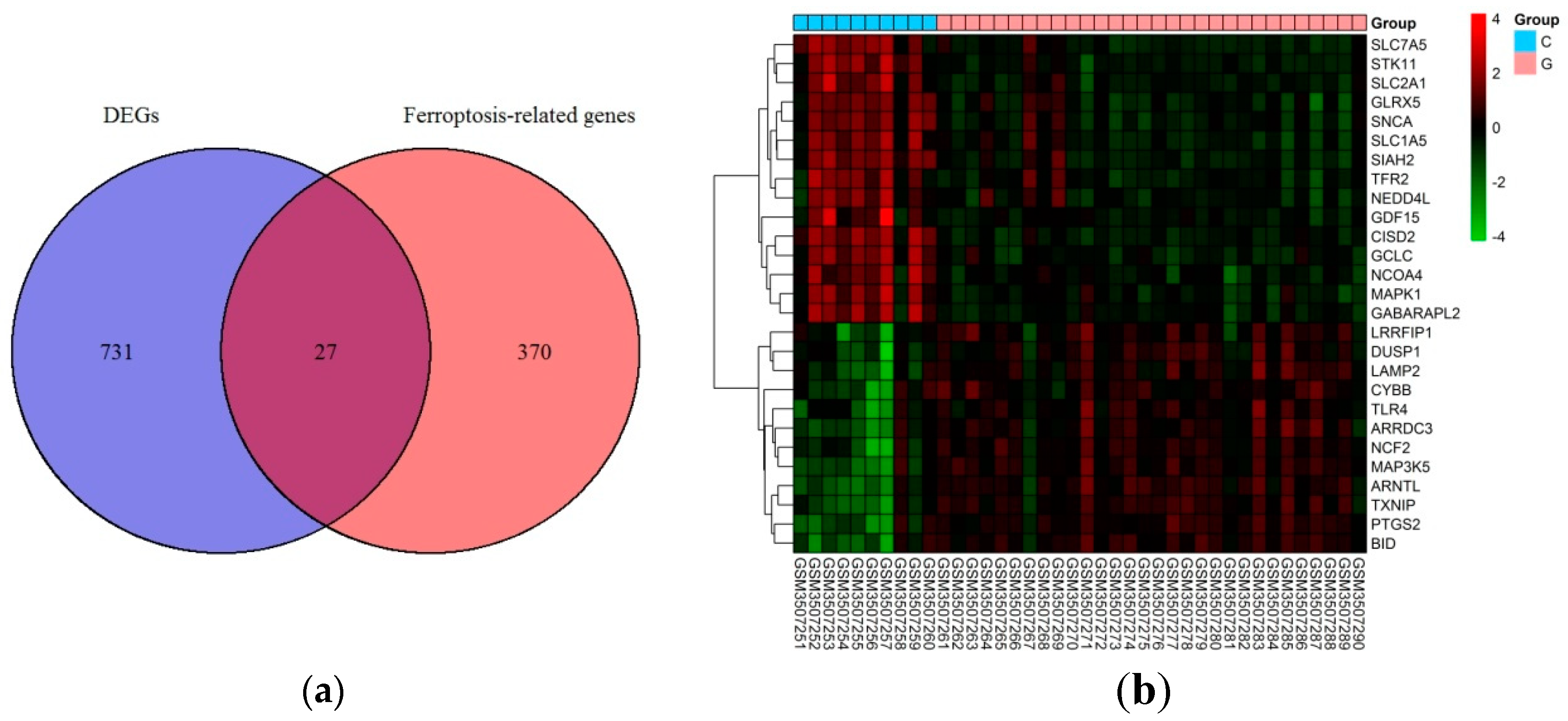
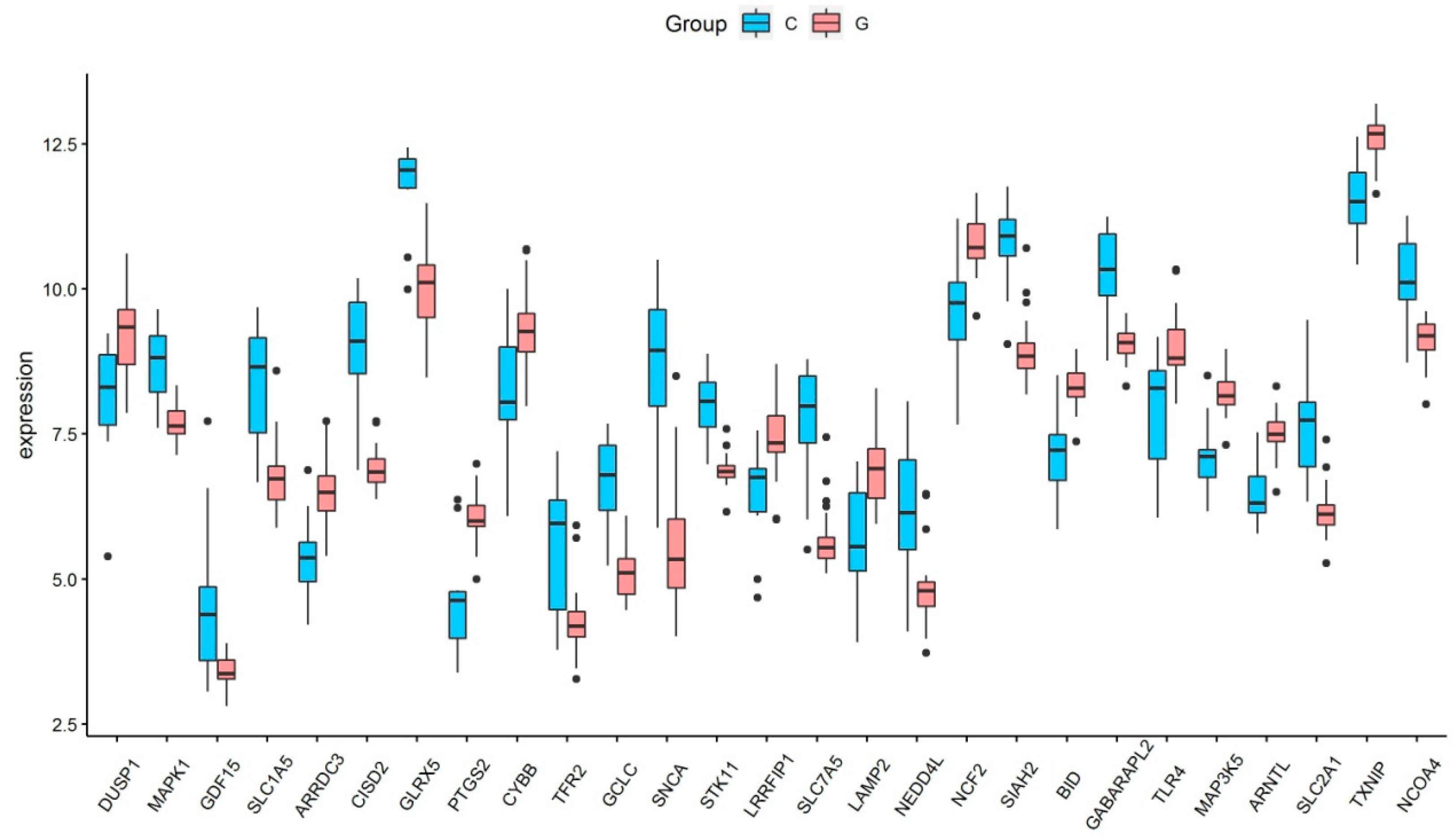
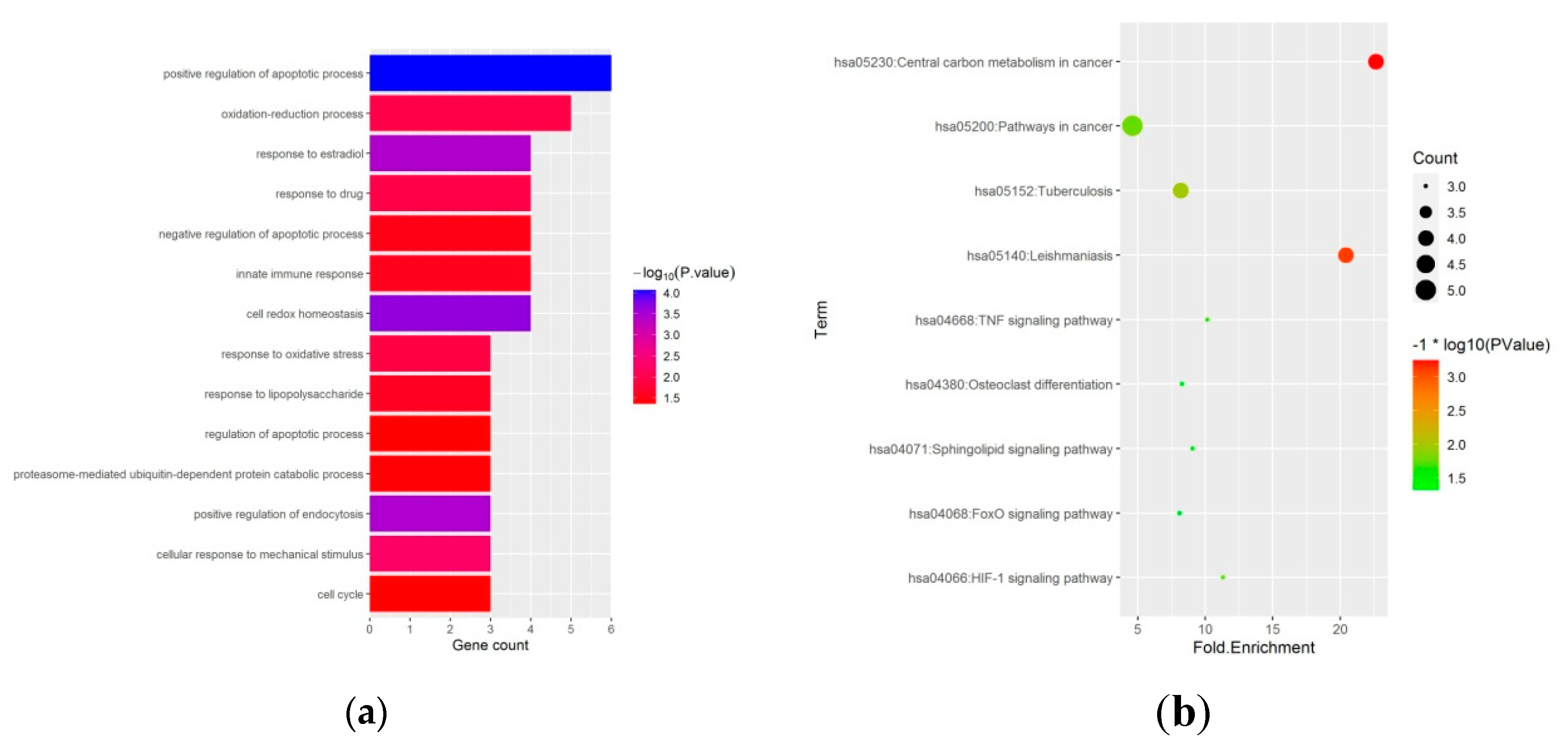
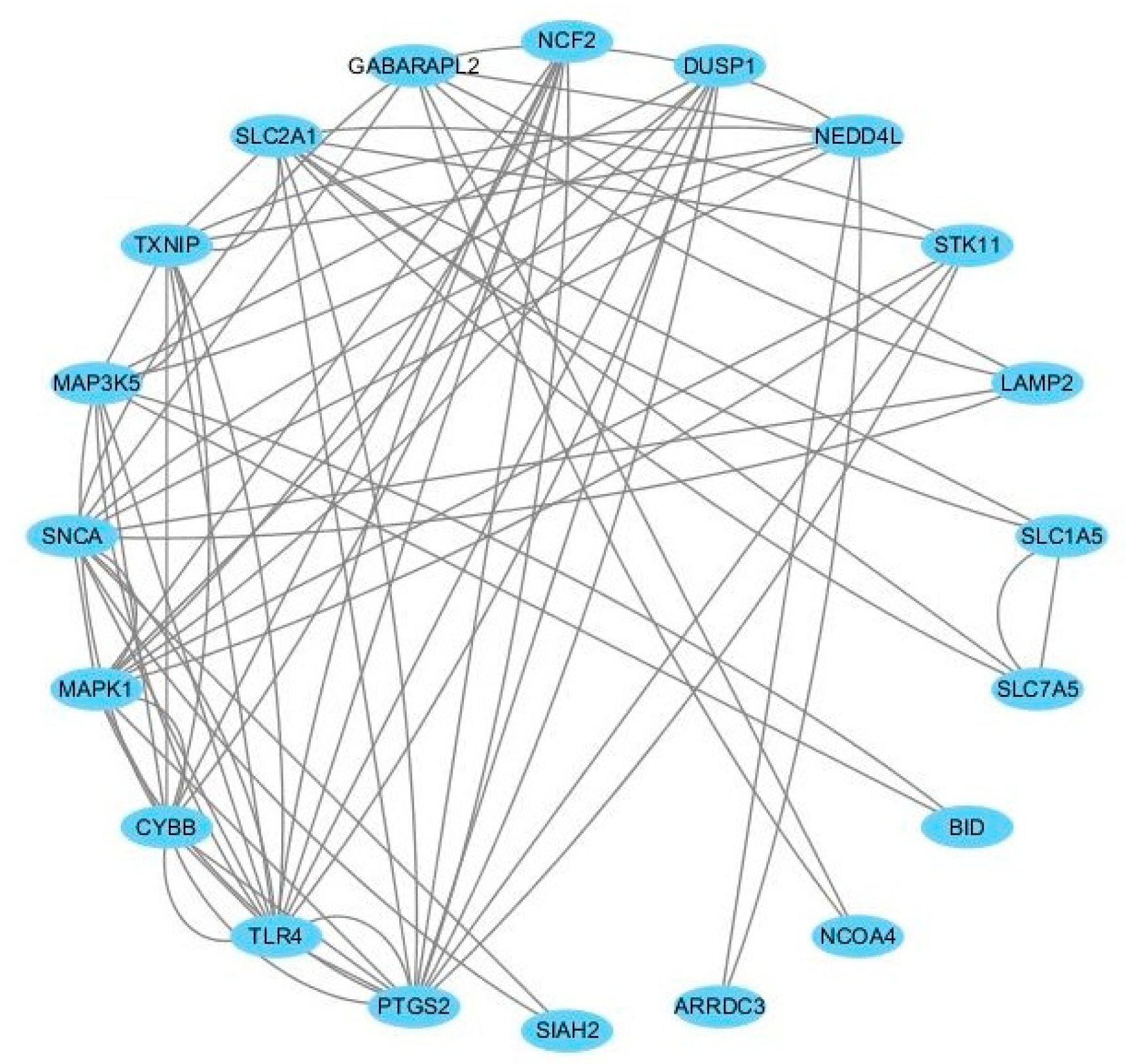
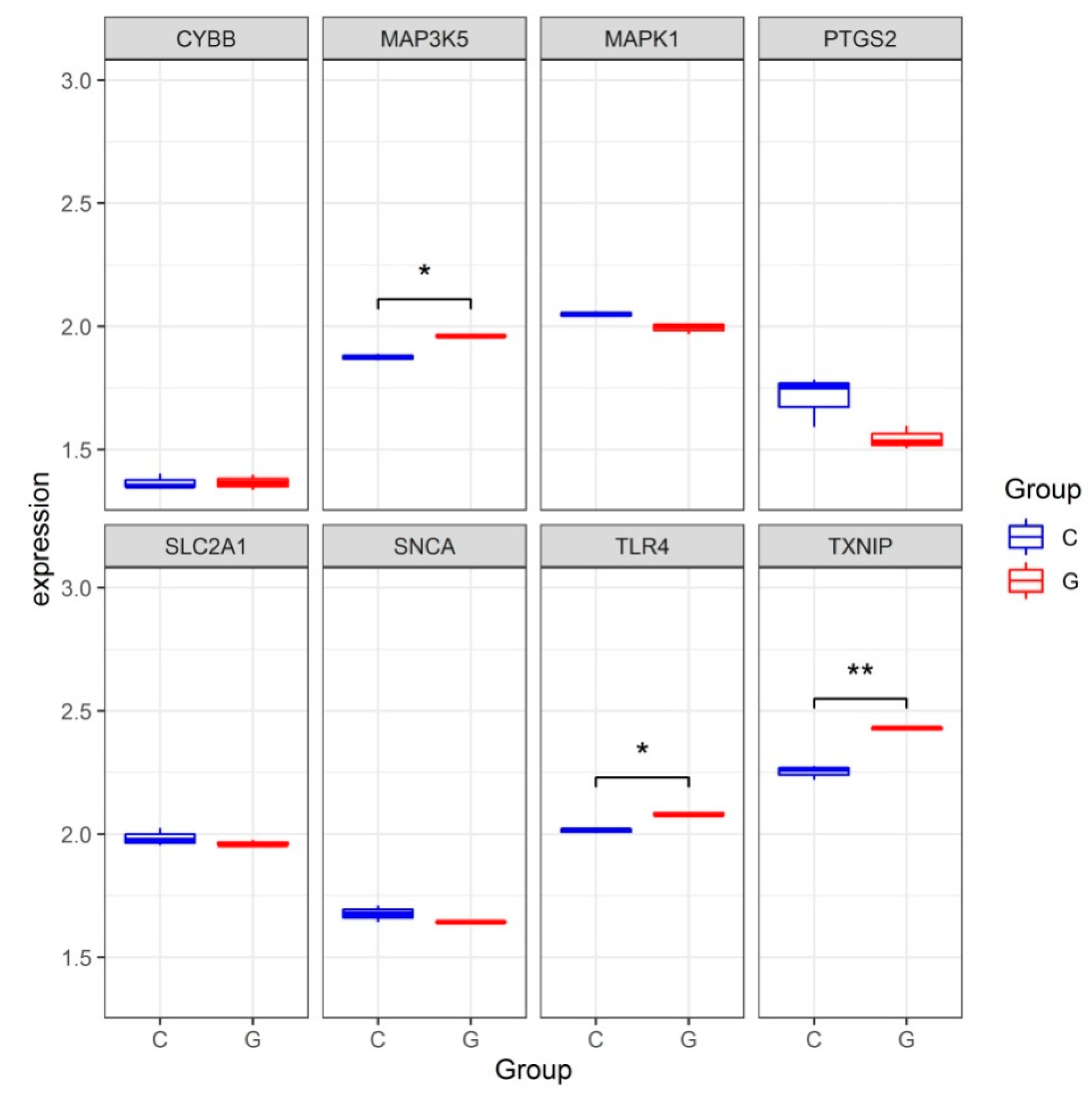
| GO Terms | Count | Enriched Genes | p-Value |
|---|---|---|---|
| positive regulation of apoptotic process | 6 | TXNIP, SNCA, PTGS2, DUSP1, MAP3K5, BID | 8.51 × 10−5 |
| oxidation-reduction process | 5 | SNCA, PTGS2, NCF2, GLRX5, CYBB | 1.23 × 10−2 |
| cell redox homeostasis | 4 | GCLC, NCF2, GLRX5, CYBB | 2.23 × 10−4 |
| response to estradiol | 4 | TXNIP, PTGS2, DUSP1, BID | 3.66 × 10−4 |
| response to drug | 4 | TXNIP, SNCA, PTGS2, CYBB | 1.12 × 10−2 |
| innate immune response | 4 | TLR4, NCF2, MAP3K5, CYBB | 2.80 × 10−2 |
| negative regulation of apoptotic process | 4 | SNCA, GCLC, DUSP1, SIAH2 | 3.23 × 10−2 |
| positive regulation of endocytosis | 3 | SNCA, TFR2, NEDD4L | 3.47 × 10−4 |
| cellular response to mechanical stimulus | 3 | TLR4, PTGS2, GCLC | 5.36 × 10−3 |
| response to oxidative stress | 3 | PTGS2, GCLC, DUSP1 | 1.24 × 10−2 |
| response to lipopolysaccharide | 3 | TLR4, SNCA, PTGS2 | 2.64 × 10−2 |
| proteasome-mediated ubiquitin-dependent protein catabolic process | 3 | SIAH2, NEDD4L, ARNTL | 3.90 × 10−2 |
| regulation of apoptotic process | 3 | DUSP1, BID, GDF15 | 4.26 × 10−2 |
| cell cycle | 3 | TXNIP, SIAH2, MAPK1 | 4.40 × 10−2 |
| KEGG Terms | Count | Enriched Genes | p-Value |
|---|---|---|---|
| hsa05200: Pathways in cancer | 5 | PTGS2, NCOA4, MAPK1, SLC2A1, BID | 1.69 × 10−2 |
| hsa05230: Central carbon metabolism in cancer | 4 | SLC7A5, MAPK1, SLC2A1, SLC1A5 | 5.67 × 10−4 |
| hsa05140: Leishmaniasis | 4 | TLR4, PTGS2, NCF2, MAPK1 | 7.69 × 10−4 |
| hsa05152: Tuberculosis | 4 | TLR4, MAPK1, BID, LAMP2 | 1.03 × 10−2 |
| hsa04066: HIF-1 signaling pathway | 3 | TLR4, MAPK1, SLC2A1 | 2.55 × 10−2 |
| hsa04668: TNF signaling pathway | 3 | PTGS2, MAP3K5, MAPK1 | 3.12 × 10−2 |
| hsa04071: Sphingolipid signaling pathway | 3 | MAP3K5, MAPK1, BID | 3.85 × 10−2 |
| hsa04380: Osteoclast differentiation | 3 | NCF2, MAPK1, CYBB | 4.51 × 10−2 |
Disclaimer/Publisher’s Note: The statements, opinions and data contained in all publications are solely those of the individual author(s) and contributor(s) and not of MDPI and/or the editor(s). MDPI and/or the editor(s) disclaim responsibility for any injury to people or property resulting from any ideas, methods, instructions or products referred to in the content. |
© 2023 by the authors. Licensee MDPI, Basel, Switzerland. This article is an open access article distributed under the terms and conditions of the Creative Commons Attribution (CC BY) license (https://creativecommons.org/licenses/by/4.0/).
Share and Cite
Chen, N.; Meng, Y.; Zhan, H.; Li, G. Identification and Validation of Potential Ferroptosis-Related Genes in Glucocorticoid-Induced Osteonecrosis of the Femoral Head. Medicina 2023, 59, 297. https://doi.org/10.3390/medicina59020297
Chen N, Meng Y, Zhan H, Li G. Identification and Validation of Potential Ferroptosis-Related Genes in Glucocorticoid-Induced Osteonecrosis of the Femoral Head. Medicina. 2023; 59(2):297. https://doi.org/10.3390/medicina59020297
Chicago/Turabian StyleChen, Ning, Yuan Meng, Huixian Zhan, and Gang Li. 2023. "Identification and Validation of Potential Ferroptosis-Related Genes in Glucocorticoid-Induced Osteonecrosis of the Femoral Head" Medicina 59, no. 2: 297. https://doi.org/10.3390/medicina59020297
APA StyleChen, N., Meng, Y., Zhan, H., & Li, G. (2023). Identification and Validation of Potential Ferroptosis-Related Genes in Glucocorticoid-Induced Osteonecrosis of the Femoral Head. Medicina, 59(2), 297. https://doi.org/10.3390/medicina59020297





